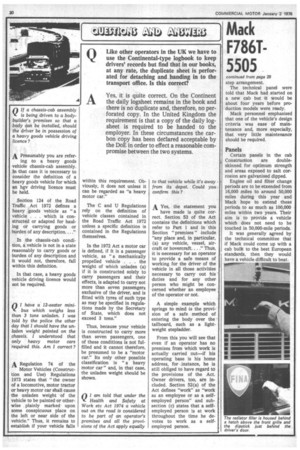Q I have a 12-seater mini' 1 ‹ bus which weighs less than
Page 32

If you've noticed an error in this article please click here to report it so we can fix it.
3 tons unladen. I was told by the police the other day that I should have the unladen weight painted on the chassis. I understood that only heavy motor cars required this. Am I correct
A
Regulation 74 of the Motor Vehicles (Construction and Use) Regulations 1973 states that "the owner of a locomotive, motor tractor or heavy motor car shall cause the unladen weight of the vehicle to be painted or otherwise plainly marked upon some conspicuous place on the left or near side of the vehicle." Thus, it remains to establish if your vehicle falls within this requirement. Obviously, it does not unless it can be regarded as "a heavy motor car."
The C and U Regulations rely on the definition of vehicle classes contained in the Road Traffic Act 1972 unless a specific definition is contained in the Regulations themselves.
In the 1972 Act a motor car is defined, if it is a passenger vehicle, as "a mechanically propelled vehicle . . . the weight of which unladen (a) if it is constructed solely to carry passengers and their effects, is adapted to carry not more than seven passengers exclusive of the driver, and is fitted with tyres of such type as may be specified in regulations made by the Secretary of State, which does not exceed 3 tons."
Thus, because your vehicle is constructed to carry more than seven passengers, one of these conditions is not fulfilled and it cannot therefore, be presumed to be a "motor car." Its only other possible classification is "a heavy motor car" and, in that case, the unladen weight should be shown.




































































